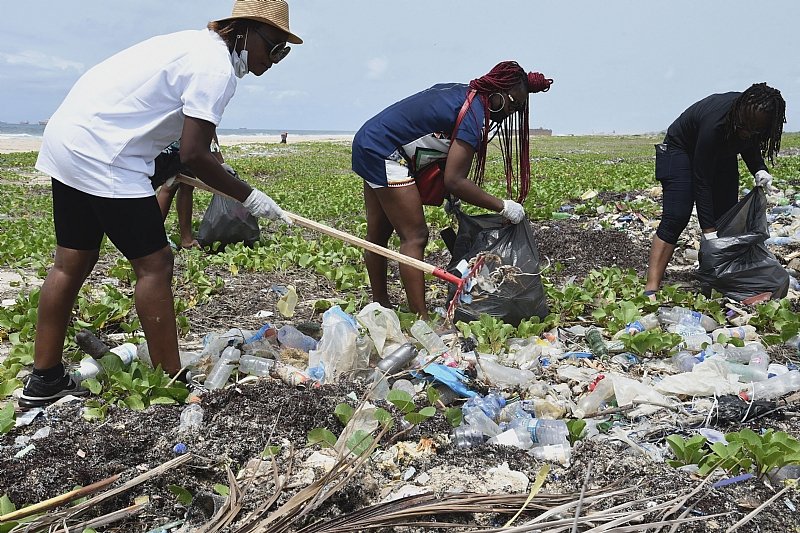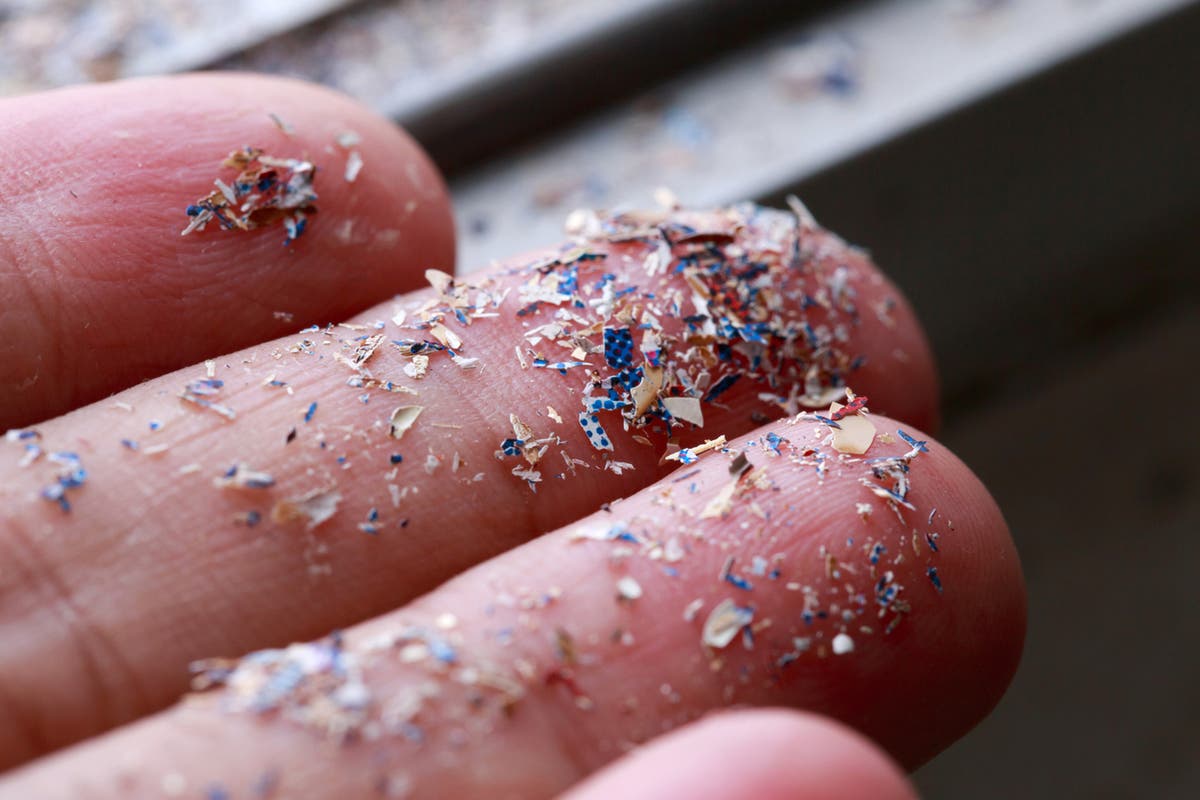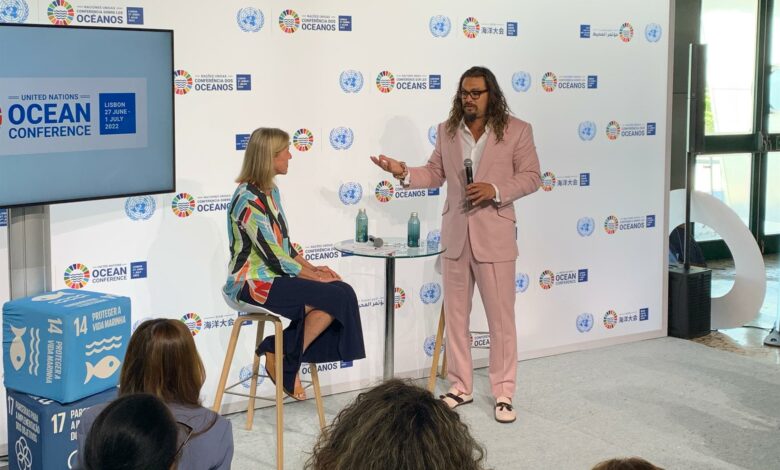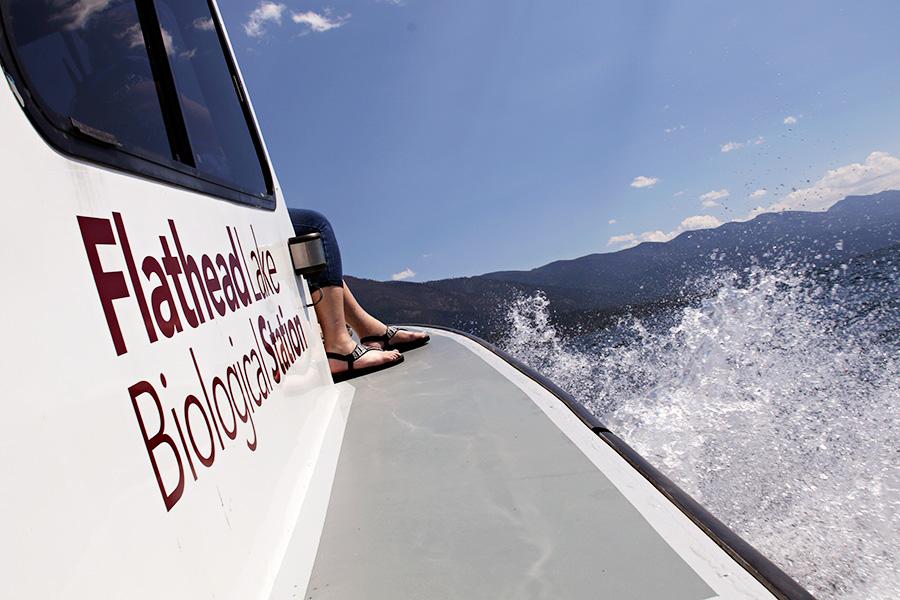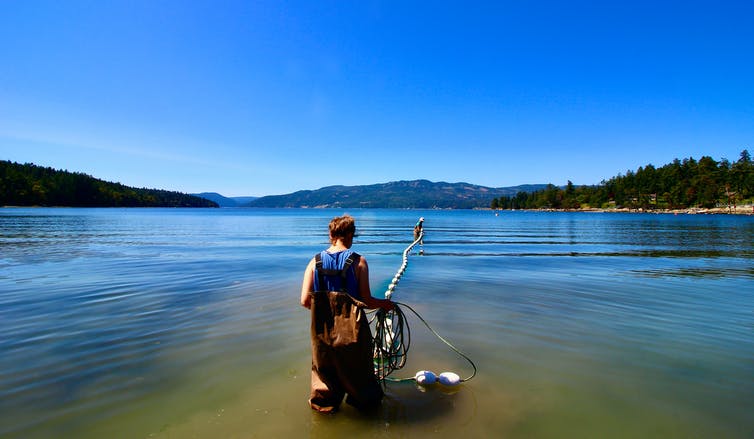In recent years, the amount of plastic in the environment has become a global concern. With the world population approaching eight billion , more and more plastic and plastic-derived products are being used and discarded. An estimated 367 million tonnes (367 billion kg) of plastic were produced in 2020 alone – about 12 tonnes (12,000kg) of plastic waste produced every second that year. With about 2.5 million tonnes of plastic waste annually, Nigeria ranks ninth globally among countries with the highest contributions to plastic pollution. Unfortunately, over 88% of the plastic waste generated in Nigeria is not recycled . Instead, much of it ends up in water bodies – rivers, lakes, drains, lagoons and the ocean. Waste comes in sizes ranging from macroplastic (pieces larger than 25 millimetres in diameter) to nanoplastic (less than 1,000 nanometers). It takes various forms, such as polyethylene terephthalate (used for food packaging, beverages, and personal care products), polyvinyl chloride (used in plumbing pipes, flooring, and clothing) and polystyrene (used for food packaging, laboratory materials, toys and computer housing). Studies globally have demonstrated the adverse impacts of plastic waste on the environment. For example, it can cause intestinal damage when ingested by fishes and turtles . Microplastic particles (less than 5mm long) have been shown to be potential vectors of disease agents . Plastic has been reported in cooking salt , stool and drinking water (tap, bottled, and sachet), with potential risks to human health. Sustaining life in water and on land is among the United Nations Sustainable Development Goals . This makes it necessary to have a clear idea of where the plastic pollution is coming from, what harm it is causing and what the authorities can do about it. Plastic waste in NigeriaWe conducted a systematic review of academic studies on plastic pollution in the environment in Nigeria. There were relatively few. As at 30 May 2021 there were only 26 such studies in Nigeria, compared to 62 peer-reviewed studies on the Arctic Ocean . Between 1987 and September 2020, there were 59 studies on the African aquatic environment . We looked for the main sources and types of plastic waste in Nigeria and their biological effects. We identified big research gaps but were able to make some recommendations. The studies indicate that water sachets and shopping bags are the major constituents of plastic waste in Nigeria. Educational institutions, markets and households are among the major routes. They are indirect routes of entry of plastic waste, particularly into water bodies in Nigeria. Read more: Lagos beaches have a microplastic pollution problem Markets are one of the major sources of plastic pollution. Frédéric Soltan/Corbis via GettyImages The sources of plastic waste included tyre wear, cigarette butts and electronic waste (mobile phone components, electronics, electrical appliances). Others were fishing ropes, biosolids, cosmetics, clothing, food packs, and cellphone bags. Microplastic particles were found in some insects, snails and fish sampled from water bodies as well as in table salt (mostly in Southern Nigeria). Research gaps Further research is needed to establish holistic evidence of plastic pollution from all sources across the six geopolitical zones in Nigeria. We also need to know more about its effect on agricultural soils, air, plants, animals, drinking water and human health as well as the socio-economic and psycho-social impact. Despite these gaps, the evidence for land-based sources indirectly polluting water bodies and the oceans is a concern. With increasing evidence of climate change in Nigeria , such as floods, the chances for transfer of plastic waste from indirect sources into the aquatic environment are higher. Next steps The low level of recycling – less than 12% – and inadequate waste collection pose a huge threat to plastic pollution management in Nigeria. Read more: Nigeria’s plastic pollution is harming the environment: steps to combat it are overdue Some African countries have taken steps to curb plastic waste discarded into the environment. They are gradually eliminating or banning single-use plastics. They have also made producers more responsible through buy-back programmes . Education about plastic pollution management should start at the elementary level and continue into adulthood. The informal sector also has a role in curbing plastic waste in the environment. Policies and incentives, backed by robust enforcement, should target plastic producing companies to encourage polymer replacement and recycling. Researchers need up-to-date facilities and funds to evaluate plastic footprint and the risk to animals and humans. They should explore trans-disciplinary approaches to curbing plastic pollution, including using innovative technologies. Temitope O. Sogbanmu works for the University of Lagos, Nigeria. She is affiliated with the Evidence Use in Environmental Policymaking in Nigeria (EUEPiN) Project, The African Academy of Sciences (The AAS), the Nigerian Young Academy (NYA), and other Professional Environmental Societies. By Temitope O. Sogbanmu, Lecturer I, Ecotoxicology and Conservation Unit, Department of Zoology, Faculty of Science, University of Lagos
Category Archives: Plastic Pollution Articles & News
Viruses can survive in water by ‘hitch-hiking’ on microplastics, new study finds
Viruses can survive and remain infectious by “hitch-hiking” on microplastics in freshwater, scientists have found, raising concern about the impact on human health.Researchers from the University of Stirling found that rotavirus, which causes diarrhoea and an upset stomach, could survive for up to three days in lake water by binding itself to the surfaces of microplastics.“Microplastics are so small that they could potentially be ingested by someone swimming,” said Professor Richard Quilliam, lead researcher on the project. “Sometimes they wash up on the beach as lentil-sized, brightly coloured pellets called nurdles that children might pick up and put in their mouths.” “It doesn’t take many virus particles to make you sick,” he added. The study published in the journal Environmental Pollution was the first to explore the issue in nature, with previous research focusing on the spread of viruses in sterile hospital settings. It is part of a larger project called the Plastic Vector project, funded by the Natural Environment Research Council, which is investigating how plastics in the environment can help transport bacteria and viruses, and the impact that may have on human health.Even if a wastewater treatment plant is doing all it can to clean sewage waste, the water discharged still has microplastics in it that are then transported down river into an estuary and end up on the beach, Prof Quilliam said.Some viruses can also release themselves from the plastic into the water or sand meaning their persistence in the environment is increased, he added.The scientists also only tested how long pathogens can survive on microplastics for up to three days, meaning it’s possible they could last longer.Microplastics are tiny plastic particles under 5mm in size that pollute the world’s environment. They have been found across the planet – from the world’s oceans, to the air we breathe, and even in our blood.The new study coincides with an ongoing scandal over the state of England’s waterways. Pollution in the bodies of water has long alarmed environmentalists, politicians and members of the public, with government data showing that every river in England is polluted.In March, water companies admitted discharging raw sewage into England’s rivers, estuaries and seas around 1,000 times a day in 2021, according to government data.While sewage firms are permitted to do this during times of heavy rainfall, the Environment Agency said they have allowed far too many spills.Last week, Richard Foord, the newly-elected MP for Tiverton and Honiton constituency in Devon told The Independent his 12-year-old son and one of his friends recently got sick after swimming in their local river, where concerns have repeatedly been raised about pollution.The government has been trying to clamp down on discharges and launched a consultation on its plan to do so.
Viruses can survive in water by ‘hitch-hiking’ on microplastics, new study finds
Viruses can survive and remain infectious by “hitch-hiking” on microplastics in freshwater, scientists have found, raising concern about the impact on human health.Researchers from the University of Stirling found that rotavirus, which causes diarrhoea and an upset stomach, could survive for up to three days in lake water by binding itself to the surfaces of microplastics.“Microplastics are so small that they could potentially be ingested by someone swimming,” said Professor Richard Quilliam, lead researcher on the project. “Sometimes they wash up on the beach as lentil-sized, brightly coloured pellets called nurdles that children might pick up and put in their mouths.” “It doesn’t take many virus particles to make you sick,” he added. The study published in the journal Environmental Pollution was the first to explore the issue in nature, with previous research focusing on the spread of viruses in sterile hospital settings. It is part of a larger project called the Plastic Vector project, funded by the Natural Environment Research Council, which is investigating how plastics in the environment can help transport bacteria and viruses, and the impact that may have on human health.Even if a wastewater treatment plant is doing all it can to clean sewage waste, the water discharged still has microplastics in it that are then transported down river into an estuary and end up on the beach, Prof Quilliam said.Some viruses can also release themselves from the plastic into the water or sand meaning their persistence in the environment is increased, he added.The scientists also only tested how long pathogens can survive on microplastics for up to three days, meaning it’s possible they could last longer.Microplastics are tiny plastic particles under 5mm in size that pollute the world’s environment. They have been found across the planet – from the world’s oceans, to the air we breathe, and even in our blood.The new study coincides with an ongoing scandal over the state of England’s waterways. Pollution in the bodies of water has long alarmed environmentalists, politicians and members of the public, with government data showing that every river in England is polluted.In March, water companies admitted discharging raw sewage into England’s rivers, estuaries and seas around 1,000 times a day in 2021, according to government data.While sewage firms are permitted to do this during times of heavy rainfall, the Environment Agency said they have allowed far too many spills.Last week, Richard Foord, the newly-elected MP for Tiverton and Honiton constituency in Devon told The Independent his 12-year-old son and one of his friends recently got sick after swimming in their local river, where concerns have repeatedly been raised about pollution.The government has been trying to clamp down on discharges and launched a consultation on its plan to do so.
Aquaman 2 to show effects of ocean pollution
Lisbon, Jun 27 (EFE).- Upcoming Superhero film Aquaman 2 will show the impact of pollution and global warming on oceans, US movie star and ocean activist Jason Momoa said Monday at the United Nations Ocean Conference in Lisbon. A staunch defender of recycling and limiting the use of plastics, Momoa, who plays Aquaman, made his …
Continue reading “Aquaman 2 to show effects of ocean pollution”
Study finds human-created microplastics in Flathead Lake
A recent study conducted at the University of Montana’s Flathead Lake Biological Station confirmed microplastic pollution in Flathead Lake, which can be traced back to various types of human activity. The study, while not the first to identify microplastics in Flathead Lake, made important findings surrounding how much microplastic pollution is in the lake and where it originates. The research was led by FLBS visiting researcher Dr. Xiong Xiong from the Chinese Academy of Science’s Institute of Hydrobiology.
According to the study, which was recently published in the journal Environmental Pollution, Flathead Lake carries microplastic pollutants at levels similar to or higher than other lakes in similarly populated areas. Although the levels remain low in comparison to more populated regions, such pollution should still be of concern for residents of the area who drink, bathe and recreate in the water, researchers say. While microplastic levels are not yet high enough to indicate immediate human danger, the new findings are a sign of a growing problem that could have lasting implications for the Flathead’s ecosystems.
The National Ocean Service defines microplastics as “small plastic pieces less than five millimeters long which can be harmful to our ocean and aquatic life.” Once ingested by fish and other animals, they can carry toxins into the aquatic food chain and human food products. Significant concentrations of microplastics have also been found in drinking water systems. In the Flathead’s wide-ranging bodies of water, these pollutants have many origins.
Landfills and plastic waste disposal sites are the largest source of microplastic contamination at the mouth of the Flathead River. Microplastics are often picked up from these sites by water particles and carried into the water system. In addition to waste disposal, the researchers found that the everyday laundry cycle is dumping microplastics into the lake. Much of today’s clothing is made of synthetic fabrics that break into microscopic plastics in the wash. These plastics are transported into the water supply through home septic drain fields and community water treatment plants. Human activities in the water that involve plastic boats, ropes, floats and fishing line can also be cause for concern. Many of these recreational supplies are prone to degrading, adding further microplastics to the water.
“Plastics are a part of our daily lives and they’re embedded in all of the things that we do—in our economy, in our lifestyle. A consequence of that—because plastics don’t degrade—is that they show up everywhere we look,” UM Flathead Lake Biological Station director Jim Elser told the Beacon.
Despite these concerning findings, the researchers say there are many actions that can be taken to remedy increasing levels of pollution.
On an individual scale, adopting in-line washing machine filters, reducing one’s consumption of synthetic fiber materials and limiting single-use plastics can help decrease pollution. The study also suggests larger reforms such as improving plastic waste disposal procedures, strengthening education on the dangers of plastic pollution and improving wastewater treatment systems.
Earlier this month, the U.S. Interior Department announced that it will phase out single-use plastics at national parks and other public lands over the next ten years, a move that will curb plastic consumption in Northwest Montana. While the announcement addresses certain pollution sources mentioned in the FLBS research, the policy is limited to enforcement on federal lands.
To ultimately see larger scale changes, Elser said, “we need to start switching away and using less plastic.”
Study finds human-created microplastics in Flathead Lake
A recent study conducted at the University of Montana’s Flathead Lake Biological Station confirmed microplastic pollution in Flathead Lake, which can be traced back to various types of human activity. The study, while not the first to identify microplastics in Flathead Lake, made important findings surrounding how much microplastic pollution is in the lake and where it originates. The research was led by FLBS visiting researcher Dr. Xiong Xiong from the Chinese Academy of Science’s Institute of Hydrobiology.
According to the study, which was recently published in the journal Environmental Pollution, Flathead Lake carries microplastic pollutants at levels similar to or higher than other lakes in similarly populated areas. Although the levels remain low in comparison to more populated regions, such pollution should still be of concern for residents of the area who drink, bathe and recreate in the water, researchers say. While microplastic levels are not yet high enough to indicate immediate human danger, the new findings are a sign of a growing problem that could have lasting implications for the Flathead’s ecosystems.
The National Ocean Service defines microplastics as “small plastic pieces less than five millimeters long which can be harmful to our ocean and aquatic life.” Once ingested by fish and other animals, they can carry toxins into the aquatic food chain and human food products. Significant concentrations of microplastics have also been found in drinking water systems. In the Flathead’s wide-ranging bodies of water, these pollutants have many origins.
Landfills and plastic waste disposal sites are the largest source of microplastic contamination at the mouth of the Flathead River. Microplastics are often picked up from these sites by water particles and carried into the water system. In addition to waste disposal, the researchers found that the everyday laundry cycle is dumping microplastics into the lake. Much of today’s clothing is made of synthetic fabrics that break into microscopic plastics in the wash. These plastics are transported into the water supply through home septic drain fields and community water treatment plants. Human activities in the water that involve plastic boats, ropes, floats and fishing line can also be cause for concern. Many of these recreational supplies are prone to degrading, adding further microplastics to the water.
“Plastics are a part of our daily lives and they’re embedded in all of the things that we do—in our economy, in our lifestyle. A consequence of that—because plastics don’t degrade—is that they show up everywhere we look,” UM Flathead Lake Biological Station director Jim Elser told the Beacon.
Despite these concerning findings, the researchers say there are many actions that can be taken to remedy increasing levels of pollution.
On an individual scale, adopting in-line washing machine filters, reducing one’s consumption of synthetic fiber materials and limiting single-use plastics can help decrease pollution. The study also suggests larger reforms such as improving plastic waste disposal procedures, strengthening education on the dangers of plastic pollution and improving wastewater treatment systems.
Earlier this month, the U.S. Interior Department announced that it will phase out single-use plastics at national parks and other public lands over the next ten years, a move that will curb plastic consumption in Northwest Montana. While the announcement addresses certain pollution sources mentioned in the FLBS research, the policy is limited to enforcement on federal lands.
To ultimately see larger scale changes, Elser said, “we need to start switching away and using less plastic.”
Microplastics might be entering marine food webs from the bottom up
Microplastics — tiny pieces of plastic less than five millimetres in size — have been found in marine and freshwater animals ranging from tiny zooplankton to large whales.
However, researchers are still struggling to understand the impact that microplastics are having on aquatic species.
Scientists have found that microplastics have the potential to cause harm to animals through pathways including replacing food and leaching added chemicals into their bodies. However, it’s unclear how much these effects are currently occurring in the environment.
Our recently published study explores how microplastics move within coastal marine food webs. We found that smaller animals feeding lower in the food web might be at greater risk from microplastic exposure than larger predatory animals.
Pollutants and food webs
Food webs are tangled networks of organisms feeding on each other. Where an animal is feeding within this tangled network is called its trophic position and may determine its exposure to pollutants.
For example, mercury pollution accumulates in the muscles of animals and is passed from prey to predators, reaching higher levels of concentration through the food web.
Read more:
Killer whales: why more than half world’s orcas are threatened by leftover industrial chemicals
This process is called biomagnification, and it’s why animals like tuna and salmon end up with potentially dangerous concentrations of pollutants.
Do microplastics biomagnify?
During the summer of 2018, we collected individuals — including clams, mussels, sea cucumbers, crabs, sea stars and fishes — across a food web from several sites around southern Vancouver Island.
A beach seine conducted to collect fish for the study. We found that most individuals had up to two microplastic particles in each of their guts and that the particles were mostly fibres.
(Kieran Cox), Author provided
We then determined the concentrations of microplastics found in the guts of the animals and the liver of the fishes and related these concentrations to each animal’s place in the food web.
The species of aquatic animals we analyzed for microplastic content and positions in the food web.
(Garth Covernton), Author provided
Animals higher in the food web did not contain greater concentrations of microplastics than animals lower in the food web, suggesting that biomagnification was not occurring.
Some of our past work has also shown a lack of evidence for biomagnification of microplastics. In that work, we compared microplastic concentrations in fish guts, reported in the scientific literature, with estimates of their place within food webs.
Some species might be at greater risk
Although we didn’t find evidence of biomagnification, we did find that concentrations of microplastics were higher for certain smaller species when compared to their body weight.
Microplastics did not increase at higher trophic levels — higher positions in the food web — according to a literature review.
(Garth Covernton), Author provided
This included filter feeding animals like clams, mussels and certain sea cucumbers, as well as a type of fish, the shiner surfperch. These fish might be ingesting more microplastics because the particles are similar in size and shape to their preferred food — small aquatic microorganisms like zooplankton and other small invertebrates.
However, the numbers of microplastics we found in all animals were less than two particles per individual on average. While this could mean that health risks to these animals are low, we have yet to understand how long-term exposure to low concentrations of microplastics could affect their health.
In our research, we were limited to studying particles greater than 100 microns in size — about the width of a human hair — as particles smaller than this are very difficult to study using a regular microscope. However, emerging methods may make them easier to investigate in the future. These smaller particles are potentially more toxic and we can’t rule out biomagnification at this scale, even if it’s not occurring for larger particles.
How are microplastics affecting aquatic food webs?
As microplastics pollution of the environment increases, we need to understand its possible effects to avoid potential ecosystem disasters in the future.
An aerial view of a lake with experimental enclosures where microplastics research is being conducted at the IISD-ELA, northwestern Ontario. Studying microplastics in natural freshwater labs will advance our understanding of how they might affect aquatic food webs.
(Garth Covernton), Author provided
Freshwater ecosystems, for example, are often more directly exposed to microplastics and can contain higher concentrations.
Researchers, including a member of our team, are currently conducting work at the International Institute for Sustainable Development’s Experimental Lakes Area to help understand how microplastics exposure might affect freshwater ecosystems and food webs.
This work, alongside the work of other researchers, should advance our understanding of how microplastics can affect aquatic ecosystems, especially the effects on the small animals at the base of food webs that might be ingesting more of these particles.
California lawmakers want to make brands use less single-use plastic
Instead of focusing solely on ramping up recycling, the Plastic Pollution Producer Responsibility Act would require companies to cut the amount of plastic in their packaging—and nudge them toward reusable alternatives.
[Illustration: Fast Company]
By
California lawmakers want to make brands use less single-use plastic
Instead of focusing solely on ramping up recycling, the Plastic Pollution Producer Responsibility Act would require companies to cut the amount of plastic in their packaging—and nudge them toward reusable alternatives.
[Illustration: Fast Company]
By
Can a future fleet of robotic fish clean up microplastic pollution in the ocean?
Microplastics are a menace. They’ve been found everywhere from the top of Mount Everest to melted Antarctic snow. Microplastics have even been found circulating in human blood. But perhaps the place where they are having the worst impact is in Earth’s oceans. Plastic is the single most common debris in the sea—often breaking down over time into tiny bits that are consumed by fish and capable of wreaking havoc on marine ecosystems.That’s why scientists have been working on a new method of getting rid of them for good: fish-shaped robots that can actually clean up the oceans while swimming.In a study published Wednesday in the journal Nano Letters, researchers at Sichuan University in China created a fish-bot made of a light-activated material that can absorb microplastics as it swims in water. The team believes the new bot could be used to transport pollutants to another location where they can be collected and properly disposed of. It could also be used for detecting and monitoring microplastics in harsher environments that humans can’t explore easily like the frigid waters of the arctic.“The proof-of-concept robot is demonstrated to emphasize its maximum swimming speed of 2.67 body length per second, whose speed is comparable to that of plankton,” the study authors wrote, adding that the speed outperforms similar soft robots.The fish-bot is made of a composite material that’s safe for marine environments and physically reacts when a near-infrared light laser is pointed at it. Blinking the laser on and off can cause the robot’s “tail” to flap back and forth, allowing it to mimic a real fish and swim. As it moves, microplastic material sticks to its body, much like suckerfish do to whales and sharks. On top of that, the material the Sichuan University researchers used can repair itself when cut—which means it’s effectively self-healing.While we’re still a long ways away from schools of fish-bots roaming the seas, this is still an innovative solution to the persistent problem of microplastics in our polluted oceans. It could one day provide a novel way of ridding some areas of the pollutant—just don’t eat one if you catch it on your line.

